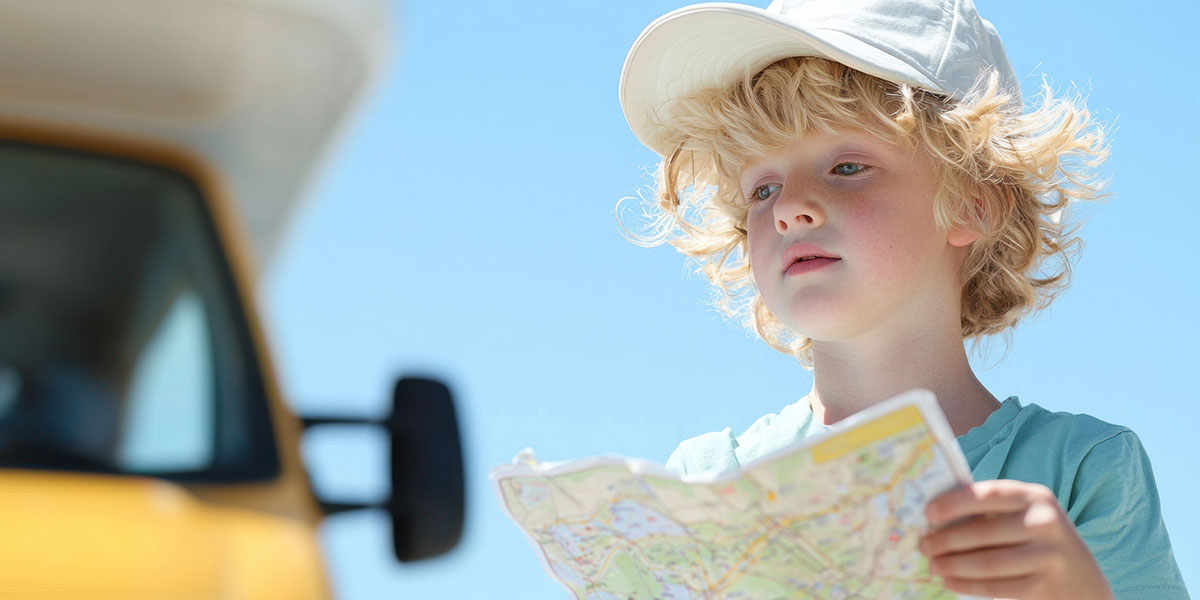Driving through Moab, Utah, my daughter stared out the window mesmerized by layers of rock laid bare. Strata of history, millions of years old, are exposed in a dusty rainbow of ancient layers. We walked past fossilized dinosaur tracks, and old dinosaur bones fused into prehistoric rock. After we set up our campsite, we put a pin in our interactive map of America on the wall. On the road, kids can associate all their rich experiences with their geographical location. What could be a better approach for teaching kids geography than through travel?
As a parent, roadschooling requires a good dose of intentionality and creativity. But the good news is that the RV life offers plenty of lessons. So, whether you’re teaching your kids about natural sciences, crunching numbers, or learning geography, there’s always something to learn.
Now let’s talk about how to work geography into your roadschool curriculum.
Applied Learning on the Road
Truth be told, not long ago, I was questioning whether or not my kids were learning all the appropriate sciences on our roadschooling agenda. When I was a kid in public school, my locker was filled with text books that covered geology, astronomy, anatomy, meteorology, geography, and so much more. Currently for my young children, our science curriculum requires this many text books: zero.
We’ve replaced the textbooks with regular field trips and applied learning. When my children show a natural interest in something, then we explore the topic with books at the nearest library. (A great move since RVs don’t have loads of book space.) We also incorporate local knowledge on the subject when applicable. The momentum of a child’s natural curiosity can propel any lesson in science, history, or art.
Starting with Interactive Maps and Research
Whether you are planning to take a year long trip across America, or a weekend away, your lesson in geography can start well before your travels. When our family started planning a trip across the country in our RV, I bought an interactive map of the country. Then we got some little pins to mark our place. We began by marking our intended route. After that, as our journey took flight, we put real time pins in each place.
We used a cork map that we hung on the wall with colorful pins. If you have the time and imagination, you can make your own map with just about anything — and use anything to mark your place.
If you have sufficient time before you embark, begin teaching your kids about your intended destinations. It will get your kids (and you) excited about the journey. (It will also prepare you for appropriate adventures to take them on when you arrive!) I love diving into the history of a place we intend to visit. I am usually surprised by intriguing historical tales that I never would have known to look for. Follow it up with a trip to a museum after you arrive. Experiences like this all contribute to rich lessons in geography.
Using Geography as a Gateway Science
If you have ever taken a class in geography, you know that it is so much more than knowing where you are on a map. It is the study of the physical features of earth, its atmosphere, and human activity as it affects and is affected by these. That includes the distribution of population and resources, land use, and industries. This is a science that segues beautifully into other sciences like geology, anthropology, mathematics (thinking in time and distance), social studies, and more.
Kicking Off Geography 101
For a simple lesson in “knowing where we are in space,” I like to go on little map-making activities with my kids. You can start with the campground, or even the inside of your RV. Have the kids make a map of a small simple space, and mark where everything is. When kids make a map of a given place, they utilize the hippocampus (an underutilized part of our brain that is going soft in today’s world of GPS).
After your kids can show a basic understanding of map making, then you can turn it up a notch. Make a treasure map, or turn it into a more complex scavenger hunt. This will engage them in the natural environment, while developing their geography skills hands on.
Why Teaching Kids Geography and Navigation Matters
It’s easy to let the navigational sides of our brain shrink, while GPS and Apple Maps take us everywhere we need to go. Because that is exactly what is happening, the hippocampus (the part of the brain that is critically involved in navigation) is shrinking.
Some might ask why it matters. Why should we bother teaching kids geography with outdated skills associated with maps and navigation? After all, everyone is always plugged into our phones, so why should we bother knowing where we are in the big picture?
For one, there are some new studies out there suggesting a connection between Alzheimer’s disease and dementia, and the disuse of the hippocampus. So, maybe it is a good idea to keep up with our geography and navigational skills, even though it may seem irrelevant with an iPhone in your pocket.
But even more than that, RV kids should enjoy the benefit of being raising differently — knowing where they are and where they are going without a screen. That skill teaches them to be present in a way that will impact their entire lives.

Leave a Reply